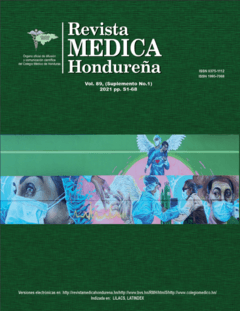Fetus in Fetu: clinical case studied with three-dimensional tomography
DOI:
https://doi.org/10.5377/rmh.v89iSupl.1.12183Keywords:
Conjoined Twins, Congenital Abnormalities, Fetus in fetu, Monozygotic TwinsAbstract
Background: Fetus in fetu (FIF) is a rare congenital anomaly of asymmetric monozygotic twins, where the parasitic twin develops abnormally within the host twin’s body. Currently there are less than 200 cases reported worldwide, this being the second case in Honduras. Clinical case: The case of a male patient, full-term newborn in the maternity ward of the Hospital “San Felipe”, who was observed at birth, abdominal distension, umbilical hernia, left inguino-scrotal hernia and a tumor in the hypochondrium are reported. left, so it was decided to perform a thoracoabdominal anteroposterior radiography revealed a tumor in the left region of the abdomen with the presence of calcifications. She refers to the University School Hospital where a total abdominal ultrasound was performed with a report of a heterogeneous mass of 5 cm3 in volume with a calcium component inside, which had to be correlated with computerized axial tomography with 3D reconstruction, resulting in a heterogeneous mass with bones. axial and appendicular inside compatible with FIF. Surgical intervention was performed with resection of the retroperitoneal tumor and its annexes without sequelae or complications, for which the doctor was discharged. Conclusion: Although FIF is a very rare disease, the treatment of choice will be resection of the mass and its prognosis is favorable when the mass is located in the retroperitoneal area. It can be observed that three-dimensional tomography is a useful imaging technique for the differentiation between a FIF and a teratoma in the preoperative diagnosis.
Downloads
329




